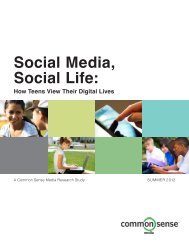Higher Education: Gaps in Access and Persistence Study
Higher Education: Gaps in Access and Persistence Study
Higher Education: Gaps in Access and Persistence Study
Create successful ePaper yourself
Turn your PDF publications into a flip-book with our unique Google optimized e-Paper software.
List of Tables<br />
Table<br />
Chapter 1—Demographic Context<br />
1-1. Percentage of children under age 18 liv<strong>in</strong>g <strong>in</strong> poverty, by liv<strong>in</strong>g arrangements, sex, race/ethnicity, <strong>and</strong><br />
nativity: 2005 <strong>and</strong> 2010..................................................................................................................................10<br />
2-1. Percentage distribution of children ages 6–18, by parents’ highest level of educational atta<strong>in</strong>ment <strong>and</strong><br />
child’s sex <strong>and</strong> race/ethnicity: 2010.................................................................................................................14<br />
3-1. Percentage of students <strong>in</strong> grades K through 12 whose parents reported participation <strong>in</strong> school-related<br />
activities, by sex <strong>and</strong> race/ethnicity: 2007.......................................................................................................18<br />
4-1. Number <strong>and</strong> percentage of children ages 5–17 who spoke a language other than English at home <strong>and</strong><br />
who spoke English with difficulty, by sex, race/ethnicity, <strong>and</strong> nativity: 2010...................................................22<br />
5-1. Percentage of students receiv<strong>in</strong>g special education services <strong>in</strong> 9th grade, by race/ethnicity <strong>and</strong> sex: 2009.......26<br />
5-2. Percentage of children ages 12–17 ever hav<strong>in</strong>g been diagnosed with a learn<strong>in</strong>g disability, by sex <strong>and</strong><br />
race/ethnicity: Selected years, 1999—2008.....................................................................................................27<br />
Page<br />
Chapter 2—Characteristics of Schools<br />
6-1. Percentage of public elementary <strong>and</strong> secondary school students enrolled <strong>in</strong> schools with 50 percent<br />
or more enrollment of specific racial/ethnic groups, by sex <strong>and</strong> race/ethnicity: 2010–11.................................32<br />
6-2. Number <strong>and</strong> percentage of public elementary <strong>and</strong> secondary school students <strong>and</strong> percentage distribution<br />
of students eligible for free or reduced-price lunch, by sex <strong>and</strong> race/ethnicity: School year 2010–11................34<br />
7-1. Number <strong>and</strong> percentage of students attend<strong>in</strong>g public elementary <strong>and</strong> secondary schools, by status of<br />
adequate yearly progress (AYP), sex, <strong>and</strong> race/ethnicity: School year 2008–09...............................................37<br />
8-1. Number <strong>and</strong> percentage distribution of students <strong>in</strong> public elementary <strong>and</strong> secondary schools, by school<br />
type, race/ethnicity, <strong>and</strong> sex: School year 2010–11..........................................................................................40<br />
Contents<br />
8-2. Number <strong>and</strong> percentage distribution of students <strong>in</strong> public elementary <strong>and</strong> secondary schools end<strong>in</strong>g<br />
<strong>in</strong> grade 12, by school type, race/ethnicity, <strong>and</strong> sex: School year 2010–11.......................................................42<br />
9-1. Percentage of high school graduates <strong>in</strong> schools offer<strong>in</strong>g advanced placement (AP) <strong>and</strong> <strong>in</strong>ternational<br />
baccalaureate (IB) courses, by subject, sex, <strong>and</strong> race/ethnicity: 2009...............................................................47<br />
9-2. Percentage distribution of high school graduates, by type <strong>and</strong> number of advanced placement (AP) or<br />
<strong>in</strong>ternational baccalaureate (IB) courses offered <strong>in</strong> school, average number of courses offered, sex, <strong>and</strong><br />
race/ethnicity: 2009........................................................................................................................................48<br />
10-1. Percentage of 9th-graders whose school counselors reported selected factors as the primary goal of the<br />
school counsel<strong>in</strong>g program, by sex <strong>and</strong> race/ethnicity: 2009...........................................................................52<br />
Chapter 3—Student Behaviors <strong>and</strong> Afterschool Activities<br />
11-1. Percentage of 9th-grade students who had ever been reta<strong>in</strong>ed <strong>in</strong> a grade, by grade level, sex, <strong>and</strong><br />
race/ethnicity: 2009........................................................................................................................................58<br />
11-2. Percentage of 9th-grade students who had ever experienced various discipl<strong>in</strong>e or attendance issues,<br />
by sex <strong>and</strong> race/ethnicity: 2009.......................................................................................................................60<br />
12-1. Percentage of students <strong>in</strong> grades 9 through 12 who reported that they were threatened or <strong>in</strong>jured with<br />
a weapon on school property, carried a weapon on school property, engaged <strong>in</strong> a physical fight on<br />
school property, or reported that drugs were made available to them on school property, by sex <strong>and</strong><br />
race/ethnicity: 2009........................................................................................................................................64<br />
List of Tables<br />
xxv












